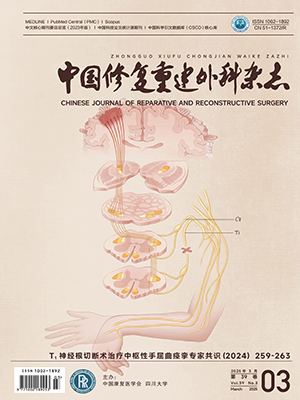Objective To investigate the expression of hypoxia inducible factor 1α (HIF-1α) protein and the activation of phosphoinositid 3-kinase/Akt (PI3K/Akt) signal ing pathway in neurons under hypoxia ischemia condition,
and to elucidate the role of PI3K/Akt on HIF-1α regulation in the developing neurons after hypoxia ischemia brain damage
(HIBD). Methods Fifty-six SD rats aged 10 days were randomly divided into normal control group (n=12), sham operation
group (n=12), experimental group (n=24), wortmannin treated group (n=4) and DMSO/PBS treated group (n=4). In the
experimental group, the rats were anesthetized with ethylether. The right common carotid artery was exposed and l igated. Then, they were exposed to hypoxia in a normobaric chamber filled with 8% oxygen and 92% nitrogen for 2.5 hours. In the sham control group, the right common carotid artery was exposed but was not l igated or exposed hypoxia. In the normal control group, the rats recevied no further processing. For wortmannin treated group and DMSO/PBS treated group, the rats received intraventricular injection of wortmannin or DMSO/PBS 30 minutes before hypoxia ischemia. The brain tissues were harvested from the rats in the normal control, sham operation and experimental groups at 4, 8 and 24 hours after hypoxia ischemia, but in the wortmannin and DMSO/PBS treated groups only at 4 hours. The HIF-1α protein expression and Akt protein expression were detected with immunohistochemistry method. HIF-1α, Akt and p-Akt protein expression were measured by Western blot analysis. Results In the experimental group, the HIF-1α expression was significantly increased at 4 hours after operation, reached the peak level at 8 hours, and began to decrease at 24 hours. The p-Akt protein was significantly increased at 4 hours, and began to decrease at 8 hours. However, the expression levels of HIF-1α and p-Akt protein in the normal control group were extremely low at each time point. So, the expression levels of HIF-1α in the experimental group was significantly higher than that in the normal control groups (P lt; 0.01), the expression of p-Akt protein in the experimental group at 4 and 8 hours was significant higher than that in the normal control group (P lt; 0.05). The change of Akt protein in the experimental group was not time-dependent, and no significant difference was evident when compared with that of the normal control group (P gt; 0.05). Using wortmannin, the PI3K/Akt specific inhibitor, HIF-1α protein expression was significantly decreased when compared with the DMSO/PBS treated group and experimental group (P lt; 0.01). Conclusion These results suggested that the HIBD of neonatal rats may activate PI3K/Akt signal ing pathway and further induce the expression of HIF-1α, indicating PI3K/Akt signal ing pathway and HIF-1α could be a potential target for treatment of neonatal HIBD.
Citation: LI Lihua,QU Yi,MAO Meng,MU Dezhi.. PHOSPHOINOSITID 3-KINASE/Akt PATHWAY INVOLVED IN REGULATION OF HYPOXIA INDUCIBLE FACTOR1α IN HYPOXIA ISCHEMIA BRAIN DAMAGE OF NEONATAL RATS. Chinese Journal of Reparative and Reconstructive Surgery, 2008, 22(9): 1102-1107. doi: Copy
Copyright © the editorial department of Chinese Journal of Reparative and Reconstructive Surgery of West China Medical Publisher. All rights reserved




